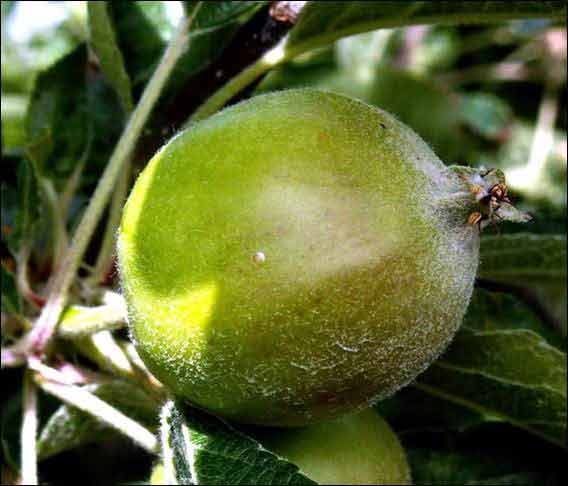Mating disruption
Mating disruption is a technique where the female sex pheromone of the codling moth is released in enormous quantities in the orchard, preventing the male moth from locating the female for mating.
This technique is safe for non-target insects and doesn’t leave pesticide residues on the fruit.
In orchards under a regular spray program, pheromone traps loaded with a 1-mg lure and placed in the lower to mid-level of the canopy are sufficient for monitoring purposes. However, in mating disruption blocks, the pheromone traps should be loaded with a 5 to 10 mg lure, and the traps should be placed in the upper canopy of the tree.
Selective insecticides
Among insecticides generally used for codling moth control, there are none with enough selectivity and effectiveness to be useful for integrated control programs.
1980s—insect growth regulators (IGR)
During the 1980s, the agricultural chemical industry made a substantial effort to develop selective insecticides for codling moth control.
Development efforts focused on insect growth regulators such as the chitin-synthesis inhibitors and juvenile hormone mimics.
1990s— ecdysone-agonists
During the 1990s, a new group of chemicals referred to as ecdysone-agonists, are highly specific, affecting only Lepidoptera.
The advantage of IGRs is that they are more selective than conventional neuroactive insecticides and have few, if any, detrimental impacts on natural enemies of pests.
Pro-insecticides
There is a number of new molecules with good selectivity known as pro-insecticides. Because of its pro-insecticide properties, Sodium Channel Blocking Insecticides require conversion into the active insecticidal form by the action in the body of the insect.
These insecticides have proven to be relatively benign to natural enemies. Codling moth larvae treated with Sodium Channel Blocking Insecticides produce neurotoxic symptoms, beginning with ataxia and feeding cessation followed by tremors, mild convulsions and progressing to a flaccid paralysis.
Molt accelerating compounds (MACs)
Molt accelerating compounds (MACs) are a novel class of insecticides that kill by disrupting the normal moulting processes of insects.
Ingestion of even a minute amount of MACs causes grubs and caterpillars to attempt a premature, lethal moult.
Ryanodine Receptor (RyR) Effectors
New group of insecticides, Ryanodine Receptor (RyR) Effectors or Calcium Homeostasis Insecticides have low impact on most key beneficial insects and they are commonly used in Australia for Codling moth control.
Cydia pomonella granulovirus (CpGV)t
Among the new options available for multi-tactic Codling moth control is a naturally occurring virus know as a Cydia pomonella granulovirus (CpGV).
Rotating it with chemical insecticides is a good means of combating resistance.
This virus is highly specific to Codling moth and it is non-infectious towards beneficial insects, wildlife and humans.
When using CpGV, the following factors must be kept in mind:
CpGV must be ingested by Codling moth larva and may not kill it immediately
the virus breaks down in the environment thus a spray may not be effective for about a week
the virus is highly lethal, a few protein occlusion bodies are all that is required to cause death.
Resistance management
In order not to lose the effectiveness of the insecticides, growers need to pay attention to resistance management. Resistance to insecticides may be defined as a heritable change in the sensitivity of a pest population that is reflected in the repeated failure of a product to achieve the expected level of control when used according to the label recommendation for that pest species.
Resistance arises through the overuse or misuse of an insecticide or acaricide against a pest species and results in the selection of resistant forms of the pest and the consequent evolution of populations that are resistant to that insecticide or acaricide.
In most cases, not only does resistance render the selecting compound ineffective but it often also confers cross-resistance to other chemically related compounds. This is because compounds within a specific chemical group usually share a common target site within the pest, and thus share a common mode of action (MoA).
It is common for resistance to develop that is based on a genetic modification of this target site. When this happens, the interaction of the selecting compound with its target site is impaired and the compound loses its efficacy.
Cross-resistance (continued next month)
See this article in Tree Fruit Oct 2016




















